As we’ve said before, the problem of extinction has taken on enormous proportions. So it has to be dealt with at all levels of influence, from the individual to the state and the world. In order to help endangered wild animals in different parts of the world, global interventions are required that cannot be accomplished by individuals. That’s why entire organizations with worldwide recognition, such as WWF and Greenpeace, are being created. With their help it became much easier to solve problems of preserving the diversity of species in the wilderness. Below we explain the main directions of work of such foundations.
Identifying rare and endangered species
Measures aimed at studying the populations of rare animal species are necessary to develop a strategy for their conservation. It is not only about determining numbers – scientists must have the fullest possible understanding of habitat characteristics, adaptation to environmental factors, fecundity and mortality, principles of migration and other components of the natural life of animals.
Creating Red Books
The first IUCN International Red Data Book appeared in 1963, before that there was no such a thing as a “rare species”. And not because there was not such a problem, just because people were only beginning to notice the consequences of their own irresponsibility. In addition to the international one, there are national and regional analogues. The Red Book is an official state document, in which an animal is automatically protected by law.
Conservation of species numbers
There is no universal plan for the solution of this problem, since each species is unique and has its own biological features. But one of the main directions can be considered artificial breeding of rare animals in nurseries, reserves and zoos. In recent decades, scientists have developed breeding programs for almost all species – this is how many representatives of the fauna, such as bison and lynx, were saved from extinction.
Creating gene banks
Cryopreservation makes it possible to freeze the biological material, to ensure the preservation of the gene pool of the endangered animals as a resource of the planet’s biodiversity. True, the mechanism is rather complicated: for each animal species it is necessary to develop its own method of genome conservation. To date, there are 22 gene banks around the world, which are located at museums, research institutes and other institutions. Cryopreservation of the germ cells of endangered wild animals is proceeding very slowly due to the difficulty of studying the details of the reproductive process of these species and their difficult accessibility.
Advocacy for the protection of flora and fauna
This method involves informing the public about the state of fauna, and it is also aimed at forming a careful attitude towards natural resources in general and animals in particular. The organization of various exhibitions, excursions, environmental trails and other events serves this purpose.
Development of rules and norms of human behavior in nature
Even if in ordinary life people rarely encounter endangered species, it doesn’t mean that they can’t contribute to the reduction of their population. As we’ve said before, everything is interconnected. Litter left in the woods, an unextinguished fire, dirty water or gasoline dumped in a river, all pose a danger to natural ecosystems.
Creating different ecological programs
Measures to conserve rare wildlife species are taken at the state, regional, or local level. Various programs involve controlling the release of poisonous substances into the environment, allocating land for protected areas, creating environmental watchdogs, and so on.
Facilitating the reacclimatization and acclimatization of animals
Resettlement of bred animal populations is not an easy task. When it comes to acclimatization, i.e. the development of a new territory by an animal, it is not often successful. It is difficult for humans to foresee all the peculiarities of biocenosis and its interaction with a species. Reaclimatization, i.e. restoration of population in former habitat, is much more successful. If the territory has not had time to change greatly, such measures are successful.
All these measures imply large-scale actions, but each of them is based on the will of individuals ensuring the movement of the whole mechanism.
